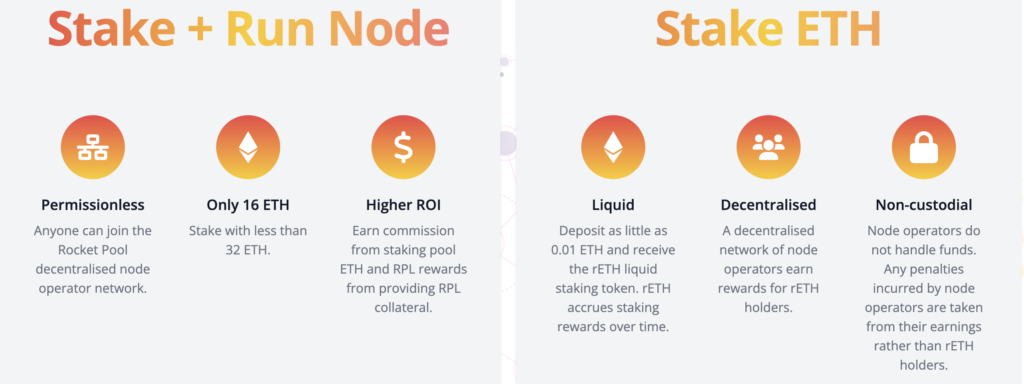We will compare and contrast activity on RocketPool vs. Lido over the past three months. Does one grow more rapidly than the other? What types of users use RocketPool instead of Lido, or do they behave similarly?
How Rocketpool Works?
Rocket Pool is an Ethereum 2.0 staking pool that enables users to stake their cryptocurrency. In addition to empowering the decentralization of the Ethereum ecosystem and increasing the security of it, the protocol aims to reduce both the capital and hardware requirements for staking on ETH 2.0. Towards this end, Rocket Pool facilitates trustless stake on an Ethereum node by letting users choose their node operator anonymously.
RocketPool is a decentralized ETH2 Staking application. Using RocketPool, users can either stake ETH or stake ETH and run a node. Users deposit ETH and mint rETH tokens. For users only interested in staking, the minimum deposit is 0.01 ETH and the rETH tokens are liquid. For users interested in running a node and staking, the minimum deposit is 16 ETH, but better rewards are received. Here we can see that ,
Staking ETH or staking ETH and running a node can be accomplished with RocketPool. As a result, the user gets the following:
- In the case of Stake + Run Node, we will receive 6.36% APR (ETH Rewards) and RPL Rewards (variable).
- If we stake ETH we will get “~ 4.03% APR (Average Rewards)”.
How Lido Works?
Lido is another application that also offers ETH2 liquid staking. Here we can see how does it works. In essence, Lido is an Ethereum smart contract that allows ETH holders with less than 32 ETH to pool their funds and earn rewards. Pooled funds are distributed among selected operators of Ethereum validators that are required for staking operations.
Lido also solves the liquidity problem of ETH stakers by issuing a special ERC20 token, stETH, at a 1:1 ratio when users deposit their ETH for staking. StETH tokens can be traded, transferred, and used in major Defi protocols, just like ETH. If a user wishes to unstake their ETH, they can sell stETH on Curve for ETH and use it however pleases them.
Compare Past 3 Months Of Activity On RocketPool And Lido
The graphs below show the total number of Lido and Rocketpool users over the past three months. Of the two apps, App Lido is the most popular, accounting for 92.21 percent of total Users. The Lido will see the highest user inflow on February 11 2022. Also, we can see from the graph that the number of users is decreasing.
Looking at the daily percentages of users that use Lido and Rocketpool, we see that more than 90% of the users use Lido services on a daily basis.
Here we compare the number of transactions made by Lido and Rocketpool on a day-to-day basis. The Lido will see the highest number of transactions on February 11 2022. In addition, the graph also indicates that the number of Transactions is decreasing. Transactions were initially increasing. Because of the upcoming Ethereum 2 release, which is expected to happen in a very short time. Later, when the postponement of release was known, the transactions were came down .
The Lido app contributed the highest percentage of transactions out of the two apps (92.3%). The percentage of transactions was decreasing for both apps.
Ethereum Inflow staking took place during March 2022 due to the release of Ethereum 2 in near future. However, users may later stop participating in Ethereum stakes after knowing the release date was delayed. Moreover, more staking of Ethereum was done by Lido . Almost 97% of the Ethereum staked has happened through Lido services. We can conclude that most users are using Lido Services instead of Rocketpool.
Initially we cans ee there is not much average inflow of Ethereum with both Lido and Rocketpool in past 3 months. But during March we cans ee a maximum average EThereum inflow was happened by Lido .
In this comparison, we can see that Lido has a higher average ethereum inflow than Rocketpool. To gain better understanding, if we compare both services average ethereum inflows for March 2022, we can see Lido has minimum almost twice as much ethereum inflow than Rocketpool. An average amount of Ethereum is not greater than 30 at Rocketpool. Accordingly, the ethereum inflow by Rocketpool is at maximum 30. Thus, based on RocketPool and Lido user profiles, we can say there are different types of users using RocketPool.
Seeing the below graph, we are able to compare Lido’s and Rocketpool’s average rate of inflow of ethereum. Between the two apps, Lido contributes the most to the average earnings (74.37%).
Observations
Based on the above analysis
- Comparing all activities such as user growth, transactions, total inflow of Ethereum, and average inflow of Ethereum on Rocketpool compared to Lido over the past three months, Lido dominates all activities such as user growth and total inflow of Ethereum. Lido services also staking has been more frequent than Rocketpool.
- By comparing these two services, we can conclude that Lido is growing more quickly and has significantly more users compared to Rocketpool. In summary, it can be concluded that Lido applications provide better user experiences than others.
- In this comparison, we can see that Lido has a higher average ethereum inflow than Rocketpool. To gain better understanding, if we compare both services average ethereum inflows for March 2022, we can see Lido has minimum almost twice as much ethereum inflow than Rocketpool.
- An average amount of Ethereum is not greater than 30 at Rocketpool. Accordingly, the ethereum inflow by Rocketpool is at maximum 30. And Lido has minimum almost twice as much average ethereum inflow than Rocketpool. Thus, based on RocketPool and Lido user profiles, we can say there are different types of users using RocketPool.


